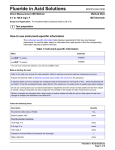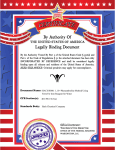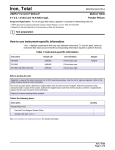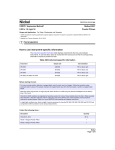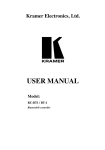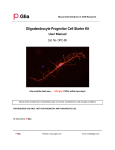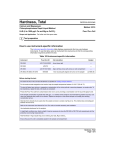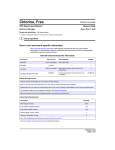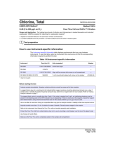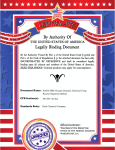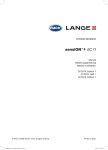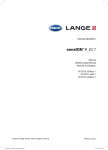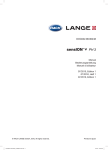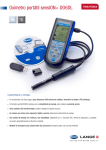Download Fluoride in Drinking Water
Transcript
Fluoride, drinking water, 8323 Fluoride in Drinking Water DOC316.53.01237 USEPA1 Direct Measurement ISE Method 0.1 to 10.0 mg/L F– Method 8323 Powder Pillow or TISAB Solution Scope and Application: Drinking water 1 USEPA equivalent method Test preparation How to use instrument-specific information The Instrument-specific information table displays requirements that may vary between instruments. To use this table, select an instrument then read across to find the corresponding information required to perform this test. Table 447 Instrument-specific information Meter 1 Electrode sension™ 4 meters 5192800 sension™ 2 meters1 5192800 The user must construct the calibration curve with the sension 2 meter. Before starting the test: Refer to the meter user manual for meter operation. Refer to electrode manual for electrode maintenance and care. For USEPA reporting, replace the standards in step 1 with a 0.5-mg/L, 1.0-mg/L and 2.0-mg/L fluoride standard solution to calibrate the electrode. Prepare the electrode. Refer to Electrode assembly and Condition the electrode in this procedure. Collect the following items: Description Fluoride ISA buffer pillows (TISAB) Quantity 1 OR Fluoride ISA solution, concentrated (TISAB) 5.0 mL Sodium acetate, ACS varies Fluoride standard solutions: 1.00-mg/L F varies 2.00-mg/L F or varies 0.5 mg/L F (USEPA) varies Potassium chloride reference electrolyte gel cartridges varies Water, deionized varies Fluoride in Drinking Water Page 1 of 10 Fluoride in Drinking Water Collect the following items: (continued) Description Quantity Beaker, 50-mL, polypropylene 3 or 4 (USEPA) Bottle, wash, 500-mL 1 Cylinder, graduated, 25-mL, polypropylene 3 Platinum series fluoride combination electrode, BNC 1 sension™2 Portable pH/ISE Meter. or sension™4 Laboratory pH/ISE Meter 1 Stir Bar, 7/8 X 3/16 in. (22.2 x 4.8 cm) 2 or 3 (USEPA) Stirrer, electromagnetic with stand and stir bar 1 See Consumables and replacement items for reorder information. Fluoride in drinking water, powder pillows method 1. In 50-mL beakers, prepare two 25-mL standard solutions of 1-mg/L and 10-mg/L F–. 2. Add the contents of one Fluoride Total Ionic Strength Adjustment Buffer (TISAB) Powder Pillow to each standard. Stir to dissolve. Standard 5. Place the electrode into the standard. Fluoride in Drinking Water Page 2 of 10 3. Turn the meter on. Set the electrode type to BNC. Set the units to mg/L. Press CAL. 4. Place the beaker with the 1-mg/L standard on a magnetic stirrer. Stir at a moderate rate. Refer to the meter user manual for details. Stabilizing... Repeat 4—7 6. Edit the display to show the concentration of the standard. 7. The display will show Stabilizing until the measurement is complete. 8. Repeat steps 4–7 for the 10-mg/L and 0.5 mg/L (USEPA) standard. Press ENTER to accept the concentration. Remove the electrode from the standard solution Rinse with deionized water and blot dry. After the last standard is measured, store the calibration in the meter. Refer to the meter user manual for details. Fluoride in Drinking Water Fluoride in drinking water, powder pillows method (continued) 9. Transfer 25 mL of the sample to a 50-mL beaker. Add a stir bar to the beaker. Place the beaker on a magnetic stirrer and stir at a moderate rate. 10. Remove the electrode from the standard solution. Rinse it with deionized water and blot dry. Place it into the sample. 11. Add the contents of one TISAB Powder Pillow. Stir to dissolve. 12. After the measurement is stable, record or store the measurement value. The sample should be the same temperature as the standards, ±1 °C. Repeat 9—12 13. Repeat steps 9 through 12 for each sample. 14. Remove the electrode after reading the last sample. Rinse the electrode. Store in a fluoride standard of similar concentration to the sample that will be analyzed next. Refer to the electrode manual for more information on electrode storage. Fluoride in Drinking Water Page 3 of 10 Fluoride in Drinking Water Fluoride in drinking water, liquid TISAB solution method 1. In 50-mL beakers, prepare two 25-mL standard solutions of 1-mg/L and 10-mg/L F–. 2. Add the contents of 5 mL concentrated Fluoride Total Ionic Strength Adjustment Buffer (TISAB) per 25 mL of standard. Stir to mix. Standard 5. Place the electrode into the standard. Fluoride in Drinking Water Page 4 of 10 3. Turn the meter on. Set the electrode type to BNC. Set the units to mg/L. Press CAL. 4. Place the beaker with the 1-mg/L standard on a magnetic stirrer. Stir at a moderate rate. Refer to the meter user manual for details. Stabilizing... 6. Edit the display to show the concentration of the standard. 7. The display will show Stabilizing until the measurement is complete. Accept the concentration. Remove the electrode from the standard solution Rinse with deionized water and blot dry. Repeat 4—7 8. Repeat steps 4–7 for the 10-mg/L standard. After the last standard is measured, store the calibration in the meter. Refer to the meter user manual for details. Fluoride in Drinking Water Fluoride in drinking water, liquid TISAB solution method (continued) 9. Transfer 25 mL of the sample to a 50-mL beaker. Add a stir bar to the beaker. Place the beaker on a magnetic stirrer and stir at a moderate rate. 10. Remove the electrode from the standard solution. Rinse it with deionized water and blot dry. Place it into the sample. 11. Add 5 mL concentrated liquid TISAB to the sample. Stir to mix. 12. After the measurement is stable, record or store the measurement value. The sample should be the same temperature as the standards, ±1 °C. Repeat 9—12 13. Repeat steps 9 through 12 for each sample. 14. Remove the electrode after reading the last sample. Rinse the electrode. Store in a fluoride standard of similar concentration to the sample that will be analyzed next. Refer to the electrode manual for more information on electrode storage. Fluoride in Drinking Water Page 5 of 10 Fluoride in Drinking Water Electrode assembly 1. Remove the cap from the electrolyte cartridge. 2. Visually inspect the Luer tip of the electrolyte cartridge. If air is present, rotate the feed-screw counter-clockwise until gel expels the air and fills the tip. 3. Fit the cartridge outlet tube firmly onto the inlet tube of the electrode body (Figure 28). Figure 28 Attach the outlet tube 4. Place the dispenser unit over the electrolyte cartridge. Screw the dispenser unit onto the electrode body until reaching the stop. Do not over tighten. 5. Dispense the electrolyte gel by pressing the pump button. Repeat this procedure until gel is visible at the reference outlet (Figure 29). Figure 29 Dispense the electrolyte gel 6. Rinse the electrode with deionized water. Do not scratch the crystal. 7. To remove an empty cartridge, unscrew the dispenser unit and rotate the cartridge counterclockwise while gently pulling it out of the electrode. Fluoride in Drinking Water Page 6 of 10 Fluoride in Drinking Water 8. Connect the BNC connector of the electrode to the BNC connector on the meter (Figure 30). Figure 30 BNC connector Note: One BNC and one 5-pin connector are on the back of the meter. Choose the BNC for the fluoride electrode. Disconnect the pH electrode from the 5-pin connector when using the BNC connector. Condition the electrode Condition and store the electrode in 1 mg/L Fluoride standard storage with Ionic Strength Adjuster for 15 to 30 minutes. For electrode storage procedures, refer to the Fluoride Electrode Instruction Manual. Clean the Lanthanum Fluoride Crystal It may be necessary to clean the LaF crystal on the sensing tip of the probe if it becomes covered with organic film or buildup. 1. 1. Put a small amount of fluoride toothpaste on a soft toothbrush or cloth. 2. Gently rub the LaF crystal with the toothpaste using a circular motion. Rub until the film is removed. 3. Thoroughly rinse the probe with deionized water and blot dry. Verify the crystal is clean. If not, repeat cleaning and rinsing until it is clean. 4. If the crystal becomes contaminated by oil, grease, or fingerprints, soak for a few minutes in isopropyl alcohol then rinse with deionized water. Interferences Table 448 Interfering substances Interfering substance Interference level Cations Do not interfere Cl–, Br–, SO42–, HCO3–, PO43–, acetate Do not interfere OH– (Hydroxyl ions) Interferes: refer to CO32– or PO43– Make the sample more basic and increase OH– Fluoride in Drinking Water Page 7 of 10 Fluoride in Drinking Water pH Effects In solutions with a pH below 5, hydrogen ion complexes some of the fluoride ions, forming the undissociated acid HF and the ion HF2–. Figure 31 shows the proportion of free fluoride ion in acid solutions. If the background ionic strength is high and constant in comparison with the ion being measured, the activity coefficient is constant and activity is directly proportional to ion concentration. Total ionic strength adjustor is added to standards and samples to make the background ionic strength high, decomplex fluoride, and adjust the solution pH to 5.0–5.5. Figure 31 Ratio of free F– in acid solutions Sample collection, preservation and storage • Collect samples in plastic bottles. • Samples may be stored up to 28 days. Accuracy check Checking electrode response To verify measurement accuracy, measure the electrode potential of two fluoride standard solutions that are one decade apart in concentration. For example, use 1-mg/L and 10-mg/L standards to bracket an expected sample concentration of 3 mg/L. The two standards should have mV potentials that are 58 ± 3 mV apart at 25 °C. Both solutions must be greater than 0.2 mg/L F–. Checking calibration accuracy To verify calibration accuracy, measure the concentration of a known standard (e.g., 2.00 mg/L) within the calibration range. Checking the accuracy of the sample reading To verify sample measurement accuracy, add a spike of standard fluoride solution with a TenSette® or volumetric pipet. Use the Spike Volumes table and the formulas in. Table 449 Spike Volumes Measured sample Concentration Volume & Concentration of F– Standard to Add CxV V C 0.6–1 mg/L 0.3 mL of... ...100-mg/L 30 1–2 mg/L 0.5 mL of... ...100-mg/L 50 3–6 mg/L 1.0 mL of... ...10-mg/L 100 Fluoride in Drinking Water Page 8 of 10 Fluoride in Drinking Water Percent recovery To calculate the percent recovery (only applicable if sample volume is 25 mL): M = S × 25 + C × V M E = ----------------25 + V A R = ---- × 100% E Where: M = calculated mass of fluoride present after the spike (micrograms) S = mg/L of F– in sample (before spike) C = concentration of standard used for spiking (mg/L) V = spike volume from the Spike Volumes table (mL) E = expected concentration after spiking (mg/L) R = percent recovery (should be 95–100%) A = actual reading on meter after spike (mg/L F–) Method performance Instrument Standard Precision 95% Confidence Limits of Distribution sension 4 1.6 mg/L 1.595–1.605 mg/L sension 2 Summary of method The fluoride electrode consists of a sensing Lanthanum Fluoride element bonded into an epoxy body. When the sensing element contacts fluoride ions in a solution, a potential develops across the sensing element. The potential is proportional to the level of fluoride ions present. The potential is measured against a constant reference potential with a pH/mV meter or ISE meter. Consumables and replacement items Required reagents Description Fluoride ISA buffer pillows Quantity/Test Unit Catalog number 1 100/pkg 258999 5 mL 3.78 L 2829017 29149 OR Fluoride ISA solution Fluoride Standard Solutions: 1.00-mg/L varies 500 mL 2.00-mg/L varies 500 mL 40520 10.0-mg/L varies 500 mL 35949 Potassium Chloride Reference Electrolyte Gel Cartridges varies 2/pkg 2546902 Water, deionized varies 4L 27256 Fluoride in Drinking Water Page 9 of 10 Fluoride in Drinking Water Required apparatus Description Quantity/Test Unit Catalog number 108041 Beaker, 50-mL, polypropylene 3 each Bottle, wash, 500-mL 1 each 62011 Cylinder, graduated, 25-mL, poly 3 each 108140 Fluoride Combination Electrode, BNC, w/ filling solution 1 each 5192800 sension 2 Portable pH/ISE Meter 1 each 5172500 1 each 5177500 1 each 4531500 OR sension 4 Laboratory pH/ISE Meter Stir Bar, 7/8 x 3/16 in. (22.2 x 4.8 cm) Select one based on available voltage: Stirrer, electromagnetic, 115 VAC, with stand and stir bar 1 each 4530001 Stirrer, electromagnetic, 230 VAC, with stand and stir bar 1 each 4530002 Description Unit Catalog number Electrode Washer each 2704700 Pipet, TenSette, 0.1 to 1. 0 mL each 1970001 50/pkg 2185696 Optional apparatus Pipet Tips, for 19700-01 TenSette Pipet FOR TECHNICAL ASSISTANCE, PRICE INFORMATION AND ORDERING: In the U.S.A. – Call toll-free 800-227-4224 Outside the U.S.A. – Contact the HACH office or distributor serving you. On the Worldwide Web – www.hach.com; E-mail – [email protected] © Hach Company, 2007, 2010, 2012. All rights reserved. Printed in the U.S.A. HACH COMPANY WORLD HEADQUARTERS Telephone: (970) 669-3050 FAX: (970) 669-2932 Edition 7










